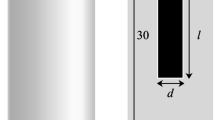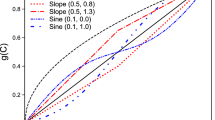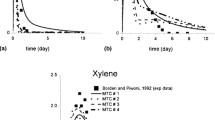Abstract
This paper investigates dynamic variation in the morphologic distribution of dense non-aqueous phase liquids (DNAPLs), which take into account the coupled mass transfer. Experiments were carried out in a 2D tank representing a reconstructed aquifer model. DNAPL dissolution rates were investigated over a wide range of DNAPL saturations, several source configurations, and different hydraulic conditions. Morphometric indexes are presented that take into consideration further factors affecting the dissolution process. Local information regarding transport parameters related to the characteristics of the medium was obtained through a neural network and an optimization algorithm applied to experimental tracer tests. The history of DNAPL source architecture, in terms of saturation, indentation grade, and orientation, was determined by image analysis. Dissolved concentrations were registered and mass transfer rate coefficients were obtained for a wide range of source-zone configurations. A statistical analysis was performed to develop a constitutive equation that is descriptive of the mass transfer rate as a function of source-zone metric characteristics. A new empirical dissolution model using the proposed morphometric parameters is presented and compared with other models. The mass transfer correlation reported incorporates morphometric parameters and considers the complex and variable architecture of non-miscible contaminants. The proposed correlation can be used for an initial assessment of non-aqueous phase liquid (NAPL) dissolution rates over a wide range of saturation (residual and non-residual) conditions and different aqueous phase velocities within the NAPL source zone.









Similar content being viewed by others
References
Agaoglu B, Scheytt T, Copty NK (2016) Impact of NAPL architecture on interphase mass transfer: a pore network study. Adv Water Resour 95:138–151
Brusseau ML, Peng S, Schnaar G, Costanza-Robinson MS (2006) Relationships among air-water interfacial area, capillary pressure, and water saturation for a sandy porous medium. Water Resour Res 42:W03501. https://doi.org/10.1029/2005WR004058
Brusseau ML, Difilippo EL, Marble JC, Oostrom M (2008) Mass-removal and mass flux-reduction behavior for idealized source zones with hydraulically poorly-accessible immiscible liquid. Chemosphere 71(8):1511–1521
Christ JA, Ramsburg CA, Pennell KD, Abriola LM (2010) Predicting DNAPL mass discharge from pool-dominated source zones. J Contam Hydrol 114:18–34
Chrysikopoulos CV (2000) Dissolution of a well-defined trichloroethylene pool in saturated porous media: experimental design and aquifer characterization. Water Res 36(7):1687–1696
Chrysikopoulos CV, Kim TJ (2000) Local mass transfer correlations for nonaqueous phase liquid pool dissolution in saturated porous media. Transp. Porous Med. 38(1/2):167–187
Chrysikopoulos CV, Hsuan PY, Fyrillas MM, Lee KY (2003) Mass transfer coefficient and concentration boundary layer thickness for a dissolving NAPL pool in porous media. J Hazard Mater B97:245–255
Clement TP, Kim Y-C, Gautam TR, Lee KK (2004) Experimental and numerical investigation of DNAPL dissolution processes in a laboratory aquifer model. Ground Water Monit Rem 24:88–96
Culligan KA, Wildenschild D, Christensen BSB, Gray WG, Rivers ML, Tompson AFB (2004) Interfacial area measurements for unsaturated flow through a porous medium. Water Resour Res 40:W12413. https://doi.org/10.1029/2004WR003278
Culligan KA, Wildenschild D, Christensen BSB, Gray WG, Rivers ML (2006) Pore-scale characteristics of multiphase flow in porous media: a comparison of air–water and oil–water experiments. Adv Water Resour 29:227–238
Dela Barre BK, Harmon TC, Chrysikopoulos CV (2002) Measuring and modeling the dissolution of nonideally shaped dense nonaqueous phase liquid (NAPL) pools in saturated porous media. Water Resour. Res 38(8). https://doi.org/10.1029/2001WR000444
Di Filippo EL, Carroll KC, Brusseau ML (2010) Impact of organic-liquid distribution and flow-field heterogeneity on reductions in mass flux. J Contam Hydrol 115(1–4):14–25
Erning K, Shafer D, Dahmke A, Luciano A, Viotti P, Petrangeli PM (2011) Simulation of DNAPL distribution depending on groundwater flow velocities using TMVOC. IAHS-AISH Publ:342–387
Erning K, Grandel S, Dahmke A, Schafer D (2012) Simulation of DNAPL infiltration and spreading behavior in the saturated zone at varying flow velocities and alternating subsurface geometries. Environ Earth Sci 65:1119–1131
Fagerlund F., Mittal M., Illangasekare T.H., Phenrat T.,. Kim H.J., Lowry G.V. (2009). Dissolution of a spatially variable non-aqueous phase liquid source: experimental study and model development. In the proceedings of TOUGH Symposium 2009, Lawrence Berkeley National Laboratory (LBNL), Berkeley, Calif., USA
Fure AD, Jawitz JW, Annable MD (2006) DNAPL source depletion: linking architecture and flux response. JContamHydro 85:118–140
Grant GP, Gerhard JI (2007a) Simulating the dissolution of a complex dense nonaqueous phase liquid source zone: 1. model to predict interfacial area. Water Resour Res 43:W12410. https://doi.org/10.1029/2007WR006038
Grant GP, Gerhard JI (2007b) Simulating the dissolution of a complex dense nonaqueous phase liquid source zone: 2. experimental validation of an interfacial area–based mass transfer model. Water Resour Res 43(2007):W12409. https://doi.org/10.1029/2007WR006039
Johnston CD, Davis GB, Bastow TP, Annable MD, Trefry MG, Furness A, Geste Y, Woodbury RJ, Rao PSC, Rhodes S (2013) The use of mass depletion–mass flux reduction relationships during pumping to determine source zone mass of a reactive brominated-solvent DNAPL. J Contam Hydrol 144:122–137
Kamon M, Endo K, Katsumi T (2004) Two-dimensional DNAPL migration affected by groundwater flow in unconfined aquifer. J. Hazard Mater 110:1–12
Khachikianm C, Harmon TC (2000) Nonaqueous phase liquid dissolution in porous media: current state of knowledge and research needs. Transp. Porous Med. 38:3–28
Kim TJ, Chrysikopoulos CV (1999) Mass transfer correlations for nonaqueous phase liquid pool dissolution in saturated porous media. Water Resour Res 35(2):449–459
Lee KY, Chrysikopoulos CV (2002) Dissolution of a well-defined trichloroethylene pool in saturated porous media: experimental results and model simulations. Water Res 36(15):3911–3918
Lee HK, Do SK, Batchelor B, Jo YH, Kong SH (2009) PCE DNAPL degradation using ferrous iron solid mixture (ISM). Chemosphere 76(8:1082–1087
Lemke LD, Abriola LM, Lang JR (2004) Influence of hydraulic property correlation on predicted dense nonaqueous phase liquid source zone architecture, mass recovery and contaminant flux. Water Resour Res 40, W12417. https://doi.org/10.1029/2004WR003061
Luciano A, Petrangeli Papini M, Viotti P (2010) Laboratory investigation of DNAPL migration in porous media. J Hazard Mater 176:1006–1017
Luciano A, Viotti P, Petrangeli Papini M (2012) On morphometric properties of DNAPL sources: relating architecture to mass reduction. Water Air Soil Pollut 223:2849–2864
Luciano A, Viotti P, Torretta V, Petrangeli Papini M, Mancini G (2013) Numerical approach to modelling pulse-mode soil flushing on a Pb-contaminated soil. J Soils Sediments 13:43–55
Luciano A, Viotti P, Mancini G, Torretta V (2018) An empirical model for the evaluation of the dissolutionrate from a DNAPL-contaminated area. Environ Sci Pollut Res. https://doi.org/10.1007/s11356-018-3193-6
Miller CT, Poirier-McNeil MM, Mayer A (1990) Dissolution of trapped nonaqueous phase liquids: mass transfer characteristics. Water Resour Res 26:2783–2796
Nambi IM, Powers SE (2003) Mass transfer correlations for nonaqueous phase liquid dissolution from regions with high initial saturations. Water Resour Res 39:1030. https://doi.org/10.1029/2001WR000667
Page JWE, Soga K, Illangasekare T (2007) The significance of heterogeneity on mass flux from DNAPL source zones: an experimental investigation. J Contam Hydrol 94:215–234
Philips J, Van Muylder R, Springael D, Smolders E (2013) Electron donor limitations reduce microbial enhanced trichloroethene DNAPL dissolution: a flux-based analysis using diffusion-cells. Chemosphere 91(1:7–13
Powers SE, Abriola LM, Weber WJ (1992) An experimental investigation of nonaqueous phase liquid dissolution in saturated subsurface systems: steady state mass transfer rates. Water Resour Res 28:2691–2705
Powers SE, Abriola LM, Weber WJ (1994) An experimental investigation of NAPL dissolution in saturated subsurface systems: transient mass transfer rates. Water Resour Res 30(2):321–332
Saba T, Illangasekare TH (2000) Effect of groundwater flow dimensionality on mass transfer from entrapped nonaqueous phase liquid contaminants. Water Resour Res 36:971–979
Saenton S, Illagasekare TH (2007) Upscaling of mass transfer rate coefficient for the numerical simulation of dense nonaqueous phase liquid dissolution in heteogeneous aquifers. Water Resour Res 43:W02428. https://doi.org/10.1029/2005WR004274
Sale TC, McWhorter DB (2001) Steady state mass transfer from single-component dense nonaqueous phase liquids in uniform flow fields. Water Resour Res 37(2):393–404
Seagren EA, Rittmann BE, Valocchi AJ (1999) A critical evaluation of the local-equilibrium assumption in modeling NAPL-pool dissolution. J Contam Hydrol 39:109–135
Shafieiyoun S, Thomson NR (2018) The role of intra-NAPL diffusion on mass transfer from MGP residuals. J Contam Hydrol 213:49–61
Soga K, Page JWE, Illangasekare TH (2004) A review of NAPL source zone remediation efficiency and the mass flux approach. J Hazard Mater 110:13–27
Tosco T, Bosch J, Meckenstock R, Sethi R (2012) Transport of ferrihydrite nanoparticles in saturated porous media: role of ionic strength and flow rate. Environ Sci Technol 46:4008–4015
Trulli E, Morosini C, Rada EC, Torretta V (2016) Remediation in situ of hydrocarbons by combined treatment in a contaminated alluvial soil due to an accidental spill of LNAPL. Sustainability 8:1–14
Tsai WT (2005) Environmental risk assessment of hydrofluoroethers (HFEs). J. Hazard. Mater. A119:69–78
Viotti P, Liuti G, Di Genova P (2002) Athmospheric urban pollution: application of an artificial neural network (ANN) to the city of Perugia (IT). Ecol Model 148:27–46
Viotti P, Di Palma PR, Aulenta F, Luciano A, Mancini G, Petrangeli Papini M (2014) Use of a reactive transport model to describe reductive dechlorination (RD) as a remediation design tool: application at a CAH-contaminated site. Environ Sci Pollut Res 21:1514–1527
Vogler ET, Chrysikopoulos CV (2001) Dissolution of nonaqueous phase liquid pools in anisotropic aquifers. Stoch Env Res Risk A 15:33–46
Wu B, Li H, Du X, Zhong L, Yang B, Du P, Gu Q, Li F (2016) Correlation between DNAPL distribution area and dissolved concentration in surfactant enhanced aquifer remediation effluent: a two-dimensional flow cell study. Chemosphere 144:2142–2149
Yang M, Annable MD, Jawitz JW (2016) Solute source depletion control of forward and back diffusion through low-permeability zones. J Contam Hydrol 193:54–62
Yang M, Annable MD, Jawitz JW (2017) Field-scale forward and back diffusion through low-permeability zones. J Contam Hydrol 202:47–58
Zhou D, Dillard LA, Blunt MJ (2000) A physically based model of dissolution of nonaqueous phase liquids in the saturated zone. Transp Porous Med 39:227–255
Zhu J, Syke JF (2000) The influence of NAPL dissolution characteristics on field-scale contaminant transport in subsurface. J Contam Hydrol 41:133–154
Author information
Authors and Affiliations
Corresponding author
Additional information
Responsible editor: Marcus Schulz
Rights and permissions
About this article
Cite this article
Luciano, A., Mancini, G., Torretta, V. et al. An empirical model for the evaluation of the dissolution rate from a DNAPL-contaminated area. Environ Sci Pollut Res 25, 33992–34004 (2018). https://doi.org/10.1007/s11356-018-3193-6
Received:
Accepted:
Published:
Issue Date:
DOI: https://doi.org/10.1007/s11356-018-3193-6




